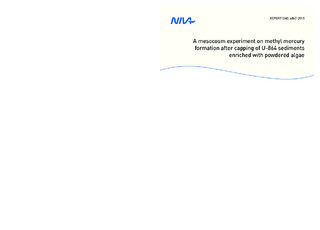| dc.contributor.author | Ndungu, Kuria | |
| dc.contributor.author | Schaanning, Morten | |
| dc.contributor.other | Ndungu, Kuria - Project manager | |
| dc.date.accessioned | 2015-12-04T10:40:32Z | |
| dc.date.accessioned | 2015-12-07T08:42:22Z | |
| dc.date.available | 2015-12-04T10:40:32Z | |
| dc.date.available | 2015-12-07T08:42:22Z | |
| dc.date.issued | 2015 | |
| dc.identifier | 6867 | |
| dc.identifier.citation | NIVA-rapport. 28 p. Norsk institutt for vannforskning, 2015 | nb_NO |
| dc.identifier.isbn | 978-82-577-6602-3 | |
| dc.identifier.issn | 1894-7948 | |
| dc.identifier.uri | http://hdl.handle.net/11250/2367154 | |
| dc.description.abstract | A mesocosm experiment was performed on methylation of mercury in marine sediments from the wreck site at Fedje.
The mercury contaminated sediment was enriched with zero, low, medium or high dose of labile organic carbon from
pulverized algae and either capped with a thin layer of clay or left uncapped exposed to the seawater flowing through the
mesocosm. The small fraction of methyl mercury (MeHg) of 0,006% of the total concentration (TotHg) in the batch of
sediment shipped form Fedje indicated that in situ methylation at the wreck site is low. In the boxcosms, no significant
methylation was observed in sediments with no addition of algae. In the low dose treatment, initial methylation rates were
found to be 0.2-0,3 ng MeHg m-2 day-1, but the process ceased after the first month, presumably due to depletion of the
reservoir of available algae carbon added. In medium and high dose treatments the process proceeded throughout the
experimental period at apparently constant rates proportional with the amount of algae added. Methylation was observed
in both capped and uncapped Fedje sediments, but the highest rates of methylation were observed in the capped
sediments, in which up to 0.6 ng m-2 day-1 of methyl mercury (MeHg) accumulated during the six months experimental
period. Fluxes of TotHg and MeHg to the seawater were only measured in the uncapped sediments. High fluxes were
observed in all treatments. The six months median fluxes showed a four-fold increase of TotHg from zero to high algae
addition, whereas the corresponding fluxes of MeHg increased 100x from 0,97 to 94.1 ng MeHg m-2 day-1. The flux of
MeHg could only account for a small fraction (in general less than 10% of the total flux) indicating the formation of
soluble organic complexes other than MeHg. A more long-term experiment using petrogenic hydrocarbons is
recommended to improve assessment of the risks of Hg methylation at Fedje and at Hg-contaminated wreck sites in
general. | nb_NO |
| dc.description.sponsorship | DNV-GL | nb_NO |
| dc.language.iso | eng | nb_NO |
| dc.publisher | Norsk institutt for vannforskning | nb_NO |
| dc.relation.ispartofseries | NIVA-rapport;6867 | |
| dc.rights | Navngivelse-Ikkekommersiell-DelPåSammeVilkår 3.0 Norge | * |
| dc.rights.uri | http://creativecommons.org/licenses/by-nc-sa/3.0/no/ | * |
| dc.title | A mesocosm experiment on methyl mercury formation after cappingof U-864 sediments enriched with powdered algae | nb_NO |
| dc.type | Research report | nb_NO |
| dc.date.updated | 2015-12-04T10:40:31Z | |
| dc.rights.holder | Norsk institutt for vannforskning / Norwegian institute for water research | |
| dc.subject.nsi | VDP::Matematikk og naturvitenskap: 400 | nb_NO |
| dc.subject.nsi | VDP::Mathematics and natural scienses: 400 | nb_NO |
| dc.source.pagenumber | 28 | nb_NO |
| dc.identifier.cristin | 1296963 | |
| dc.subject.keyword | Effekt av tildekking / Effect of capping | |
| dc.subject.keyword | Mesocosmos / Mesocosm | |
| dc.subject.keyword | Metylkvikksølv / Methylmercury | |
| dc.subject.keyword | Sediment / Sediment | |
| dc.relation.project | 14161 | nb_NO |


